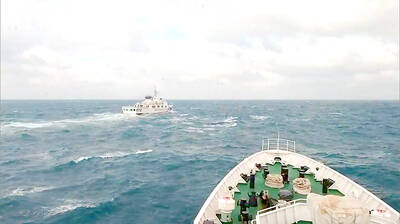Taiwan and the US have sealed a NT$3.8 billion (US$130.5 million) deal for 460 TOW-2B Aero radio frequency (RF)-controlled anti-tank missiles, which are to be delivered to Taiwan annually starting this year, with the final batch to be received by June 2024, a Ministry of National Defense source said yesterday.
The TOW-2B missiles are superior to the TOW-2A missiles the military currently uses in that they are wirelessly controlled rather than wire-guided, the source said.
The RF capability allows the missiles to more easily damage or paralyze enemy tanks by attacking them at more vulnerable points, the source said.

Photo: Lo Tien-bin, Taipei Times
After delivery of the missiles, the army’s anti-tank companies — on both Taiwan proper and its outlying islands — would have priority in deploying the missiles, the source said.
The TOW-2B’s maximum range of 4.5km allows it to be used not only in ground battles, but also to prevent enemy landings by engaging hovercraft and amphibious landing vehicles, the source said.
The sale is part of an arms package announced by the US in December 2015, originally for 769 TOW-2B RF missiles along with training equipment and support systems for a total of US$268 million, the source said.
After assessing the military’s equipment, the ministry elected to purchase 460 missiles due to a healthy number of TOW-2A missiles still in use, the source said.
The move was also a means to incentivize the Chungshan Institute of Science and Technology (CSIST) to make breakthroughs in research and development and produce anti-tank weaponry on a par with the TOW-2B, the source said.
The deal was officially signed by the Taiwanese defense attache and the American Institute in Taiwan, and was promulgated by the ministry on Thursday.
The CSIST is building missiles based on the Kestrel anti-armor rocket and has achieved multiple breakthroughs on key technologies, adding it is possible that the final product could produce an anti-tank missile at the level of the portable F6M-1HB Javelin or the TOW-2B.
The CSIST has also developed a Kestrel variant that can reach targets more than 1,200m away, a drastic improvement over the current Kestrel, which only has a range of 400m, the source said.
The CSIST’s Kestrel variant would be able to penetrate up to 400mm of rolled homogenous armor, which is an improvement on the original Kestrel’s penetration rate of 300mm, the source added.

Auckland rang in 2026 with a downtown fireworks display launched from New Zealand’s tallest structure, Sky Tower, making it the first major city to greet the new year at a celebration dampened by rain, while crowds in Taipei braved the elements to watch Taipei 101’s display. South Pacific countries are the first to bid farewell to 2025. Clocks struck midnight in Auckland, with a population of 1.7 million, 18 hours before the famous ball was to drop in New York’s Times Square. The five-minute display involved 3,500 fireworks launched from the 240m Sky Tower. Smaller community events were canceled across New Zealand’s

The Ministry of Foreign Affairs (MOFA) yesterday said it is closely monitoring developments in Venezuela, and would continue to cooperate with democratic allies and work together for regional and global security, stability, and prosperity. The remarks came after the US on Saturday launched a series of airstrikes in Venezuela and kidnapped Venezuelan President Nicolas Maduro, who was later flown to New York along with his wife. The pair face US charges related to drug trafficking and alleged cooperation with gangs designated as terrorist organizations. Maduro has denied the allegations. The ministry said that it is closely monitoring the political and economic situation

‘SLICING METHOD’: In the event of a blockade, the China Coast Guard would intercept Taiwanese ships while its navy would seek to deter foreign intervention China’s military drills around Taiwan this week signaled potential strategies to cut the nation off from energy supplies and foreign military assistance, a US think tank report said. The Chinese People’s Liberation Army (PLA) conducted what it called “Justice Mission 2025” exercises from Monday to Tuesday in five maritime zones and airspace around Taiwan, calling them a warning to “Taiwanese independence” forces. In a report released on Wednesday, the Institute for the Study of War said the exercises effectively simulated blocking shipping routes to major port cities, including Kaohsiung, Keelung and Hualien. Taiwan would be highly vulnerable under such a blockade, because it

UNRELENTING: China attempted cyberattacks on Taiwan’s critical infrastructure 2.63 million times per day last year, up from 1.23 million in 2023, the NSB said China’s cyberarmy has long engaged in cyberattacks against Taiwan’s critical infrastructure, employing diverse and evolving tactics, the National Security Bureau (NSB) said yesterday, adding that cyberattacks on critical energy infrastructure last year increased 10-fold compared with the previous year. The NSB yesterday released a report titled Analysis on China’s Cyber Threats to Taiwan’s Critical Infrastructure in 2025, outlining the number of cyberattacks, major tactics and hacker groups. Taiwan’s national intelligence community identified a large number of cybersecurity incidents last year, the bureau said in a statement. China’s cyberarmy last year launched an average of 2.63 million intrusion attempts per day targeting Taiwan’s critical